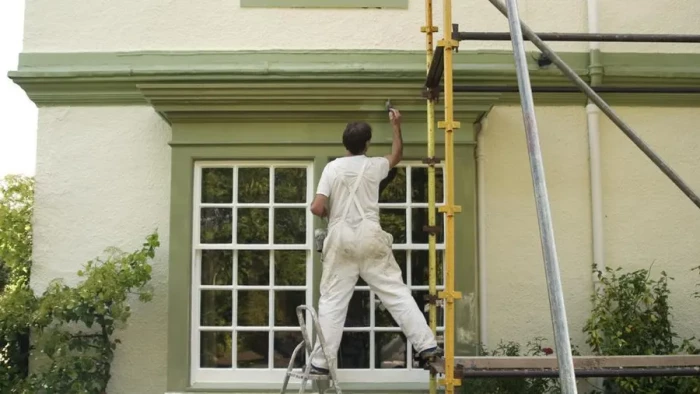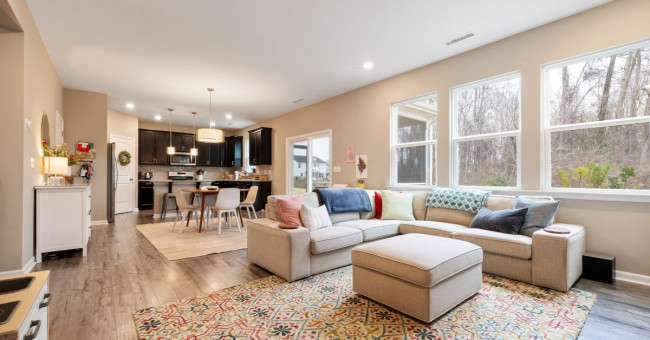There's nothing like a fresh coat of paint to instantly elevate the curb appeal of your home. Whether you're looking to give your house a facelift or simply refresh its exterior, painting is a cost-effective way to transform the look and feel of your property. With just a little effort and some strategic planning, you can easily achieve a stunning new look for your home's exterior that will have your neighbors green with envy. In this article, we'll walk you through five easy steps to help you transform your home with exterior painting.
From choosing the right color scheme to prepping the surface and applying the paint, we'll cover everything you need to know to achieve professional-looking results without breaking the bank. Whether you're a seasoned DIY enthusiast or first-time painter, these simple tips and tricks will help you get the job done quickly and efficiently, so you can enjoy a fresh new look for your home in no time.
Choosing the right paint color
Choosing the right paint color for your home's exterior can seem like a daunting task, but it doesn't have to be. With a little bit of planning and consideration, you can easily transform the look of your home with a fresh coat of paint. Here are some tips to help you choose the perfect paint color for your exterior. First, consider the style of your home.
Different architectural styles lend themselves to certain color schemes. For example, a Victorian style home might look best with bold, vibrant colors, while a modern home might look better with more subdued, neutral tones. Take cues from the style of your home to help guide your color choices. Next, consider the existing elements of your home's exterior. Take into account the color of your roof, any brick or stone accents, and the landscaping around your home. You want to choose a paint color that complements these existing elements rather than clashes with them. For example, if you have a red brick façade, you might want to choose a paint color that complements the warm tones of the brick rather than clashes with it. Another thing to consider is the overall color scheme of your neighborhood.

While you don't necessarily have to match your neighbors' homes exactly, you do want to choose a color that fits in with the overall aesthetic of the neighborhood. Consider taking a drive around your neighborhood to get a sense of what colors are popular in the area and use that as a guide for choosing your own paint color. When choosing a paint color, it's also important to consider the lighting around your home. The color of your home's exterior can look different in different lighting conditions, so it's a good idea to test out your chosen paint color in different lighting situations before committing to it. Consider how the color looks in direct sunlight, in shade, and at different times of day to ensure that it will look great no matter the lighting conditions. Lastly, don't be afraid to get creative with your paint color choices. While neutrals like whites, grays, and browns are always classic choices, don't be afraid to consider bolder, more unique colors as well. A pop of color can really make your home stand out and add personality and charm to your exterior.
Just be sure to consider the other factors mentioned above to ensure that your chosen color works well with the other elements of your home's exterior. Choosing the right paint color for your home's exterior doesn't have to be overwhelming. By considering the style of your home, existing elements, neighborhood color scheme, lighting, and getting creative with your color choices, you can easily transform the look of your home with a fresh coat of paint. Take your time, do some research, and trust your instincts to choose a color that will make your home look its best.
Prepping the exterior surfaces
Before you can start transforming your home with a fresh coat of exterior paint, it’s important to properly prep the surfaces to ensure a smooth and long-lasting finish. Prepping the exterior surfaces may seem like a daunting task, but with the right tools and techniques, it can be done efficiently and effectively. The first step in prepping your home’s exterior surfaces is to clean them thoroughly. Use a pressure washer or a garden hose with a nozzle attachment to remove dirt, grime, and mildew from the walls, trim, and any other surfaces that will be painted. Make sure to let the surfaces dry completely before moving on to the next step. Next, inspect the exterior surfaces for any damage, such as cracks, peeling paint, or rotting wood. Repair any cracks or holes with a filler or caulk, sand down any peeling paint, and replace any rotted wood before proceeding with the painting process.
By addressing these issues now, you can prevent further damage and ensure a smooth and even finish for your new paint job. After you’ve cleaned and repaired the exterior surfaces, it’s time to prime them. Priming the surfaces before painting helps to seal and protect them, as well as ensure better adhesion for the paint. Use a high-quality primer that is suitable for the type of surface you are painting, whether it be wood, metal, or masonry. Apply the primer evenly and allow it to dry completely before moving on to the final step. Once the primer is dry, it’s finally time to apply the paint. Choose a high-quality exterior paint that is suitable for the climate conditions in your area and the type of surface you are painting.
Use a brush, roller, or sprayer to apply the paint evenly, working from the top down and overlapping each stroke to prevent streaks and drips. Don’t forget to paint any trim, shutters, or other details to give your home a polished and cohesive look. After you’ve finished painting, make sure to clean up any drips or spills and allow the paint to dry completely before touching or recoating. Depending on the type of paint you used, you may need to apply a second coat for complete coverage and durability. Once the paint is dry, step back and admire your handiwork – you’ve successfully transformed your home with a fresh coat of paint! Prepping the exterior surfaces may take some time and effort, but it is a crucial step in the painting process that can make a big difference in the overall result.
By cleaning, repairing, priming, and painting your home’s exterior surfaces properly, you can ensure a beautiful and long-lasting finish that will enhance your home’s curb appeal and protect it from the elements for years to come. So roll up your sleeves, gather your tools, and get ready to transform your home with a fresh coat of exterior paint!
Selecting the necessary tools and materials
When it comes to transforming your home with exterior painting, one of the first steps you need to take is selecting the necessary tools and materials. Having the right supplies on hand can make the painting process much smoother and help you achieve professional results. First and foremost, you'll need to choose the right paint for the job. When it comes to exterior painting, it's important to select a high-quality, weather-resistant paint that will stand up to the elements and protect your home's exterior.
Look for a paint that is specifically designed for outdoor use and is durable enough to withstand rain, sun, and other weather conditions. In addition to the paint itself, you'll also need a variety of tools to complete the painting job. Some essential tools include brushes, rollers, drop cloths, painter's tape, sandpaper, and a ladder.
Make sure to choose brushes and rollers that are designed for outdoor use and are appropriate for the type of paint you'll be using. Drop cloths are essential for protecting your landscaping and other surfaces from paint splatters, while painter's tape can help you create clean, straight lines. Before you start painting, it's also a good idea to gather some additional materials to help you prepare your home's exterior for the paint job.
Depending on the condition of your home's exterior, you may need to do some cleaning, sanding, or priming before you can start painting. Be sure to have cleaning supplies, sandpaper, primer, and any other prep materials on hand before you get started. When selecting the necessary tools and materials for your exterior painting project, it's important to consider the size and scope of the job. If you're painting a large area or multiple surfaces, you may need to invest in larger quantities of paint and additional tools.
On the other hand, if you're just touching up a small area, you may be able to get by with fewer supplies. Lastly, don't forget to protect yourself while you're painting. Make sure to wear appropriate clothing, including old clothes that you don't mind getting paint on, as well as gloves and safety goggles. It's also a good idea to paint on a day with mild weather conditions and to take frequent breaks to prevent fatigue and ensure that you're painting safely.
By taking the time to select the necessary tools and materials for your exterior painting project, you can set yourself up for success and ensure that the finished result is something you can be proud of. With the right supplies on hand, you'll be well-equipped to tackle any painting job and transform your home's exterior into a beautiful, fresh new look.
Applying the paint properly
Once you’ve prepped your home for painting, it’s time to actually apply the paint. This step can make a huge difference in the overall appearance and longevity of your exterior paint job. Here are some tips for applying paint properly to transform your home:
First and foremost, make sure you’re using the right tools for the job. A high-quality paintbrush or roller can make a big difference in how your paint job turns out. Choose a brush or roller that is appropriate for the type of paint you’re using and the surface you’re painting. Investing in good tools can help you achieve a smoother finish and better coverage. Before you start painting, it’s a good idea to test a small area to make sure you’re happy with the color and finish. This can help you avoid any surprises once you’ve already started painting the entire house. If you’re using multiple cans of paint, make sure to mix them together to ensure a consistent color throughout the entire project. When you’re ready to start painting, begin by cutting in around the edges of your home with a brush. This involves painting a strip of paint about 2-3 inches wide along the edges of the walls, windows, and doors before using a roller to fill in the larger areas. This technique can help you achieve a clean and professional finish, especially around corners and edges.
As you’re applying the paint, make sure to work in small sections and keep a wet edge. This means that you should paint an entire section at once to avoid any visible lines or streaks where wet paint overlaps with dry paint. It’s also important to work quickly and smoothly to avoid visible brush or roller marks in the final finish. Don’t forget to follow the manufacturer’s instructions for drying times and recoat times. This can vary depending on the type of paint you’re using and the weather conditions in your area.
Applying a second coat of paint can help ensure a longer-lasting finish and better coverage, so make sure to give the first coat enough time to dry before applying a second coat. By following these tips and techniques for applying paint properly, you can transform the exterior of your home and give it a fresh new look. Taking the time to do the job right can help you achieve professional results and make your home the envy of the neighborhood. With a little patience and attention to detail, you can create a beautiful and long-lasting paint job that will enhance your home’s curb appeal for years to come.
Adding finishing touches and maintenance tips
After completing the initial steps of prepping, choosing colors, painting, and drying, your exterior painting project is almost complete. However, there are a few finishing touches and maintenance tips that can make a significant difference in the overall look and longevity of your freshly painted surfaces. One important finishing touch is ensuring that all of your paint lines are crisp and clean. Take the time to carefully touch up any areas where the paint may have bled onto adjacent surfaces or trim. By using a small brush or a steady hand with a paintbrush, you can achieve that professional finish that will make your home really stand out. Another important step is to properly clean up your painting supplies and work area. This includes properly disposing of any paint cans, brushes, and drop cloths, as well as cleaning up any spills or drips that may have occurred during the painting process.
By keeping your work area clean, you can ensure that your home looks its best for years to come. Once your exterior painting project is complete, it's also important to regularly maintain your newly painted surfaces. This includes inspecting your home for any signs of wear or damage, such as chipping or peeling paint. By addressing these issues early on, you can prevent further damage and prolong the life of your paint job. Regularly cleaning your exterior surfaces can also help maintain the appearance of your home.
By using a mild detergent and a soft brush or sponge, you can remove dirt, dust, and grime that may accumulate over time. This can help keep your paint looking fresh and vibrant, while also preventing mold or mildew from growing on your exterior surfaces. Additionally, inspecting and maintaining your home's caulking and seals can help prevent water damage and ensure that your paint job remains in good condition.
By resealing any cracks or gaps in your home's exterior, you can prevent water from seeping in and causing damage to your paint or underlying surfaces. Lastly, it's important to remember that regular maintenance is key to preserving the beauty and longevity of your exterior paint job. By staying on top of small repairs and regularly cleaning and inspecting your home's exterior, you can keep your paint looking great for years to come. By following these easy steps for adding finishing touches and maintenance tips to your exterior painting project, you can transform your home into a beautiful and welcoming space that you can enjoy for years to come.
In conclusion, transforming your home with exterior painting is a simple and effective way to give your property a fresh and updated look. By following these 5 easy steps, you can easily enhance your home's curb appeal and make it stand out in the neighborhood. Whether you choose to do it yourself or hire a professional, a fresh coat of paint can make a world of difference in revamping your home's exterior. So go ahead, grab a paintbrush and start transforming your home today!
















